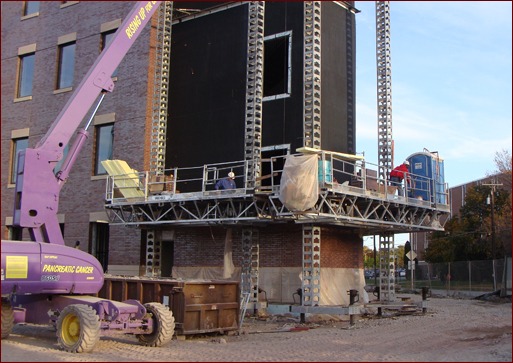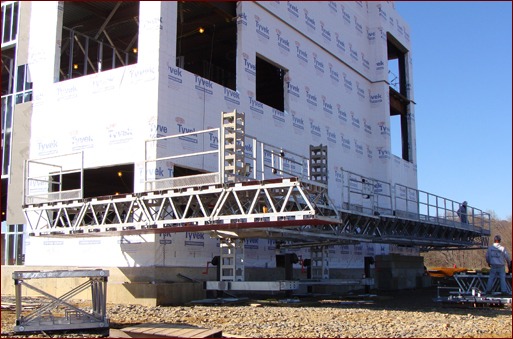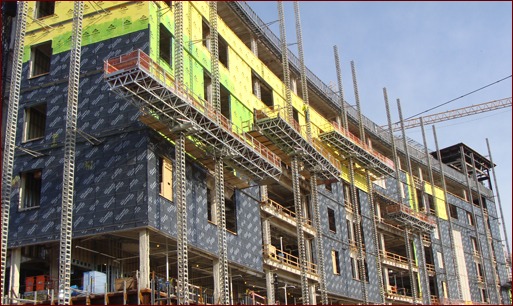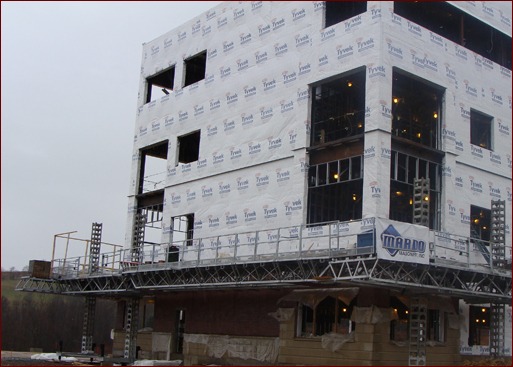Mast Climbers
Why Mast Climbers Make Sense
In 1996, I traveled regularly to Michigan, trying to sell a new product, mast climbers. The masons in Michigan were using tube-type scaffolding and or some type of crank-up scaffolding. At that time, most mason contractors thought their projects had to be high to warrant the use of mast-climbing scaffolding. After many presentations justifying the use of hydraulic mast climbers, Michigan masons began to make the switch and became the industry leaders for mast climbers. Once a customer realized that mast climbers raised production by 20 percent or more, and lowered labor costs when compared to traditional scaffold methods, they were hooked.
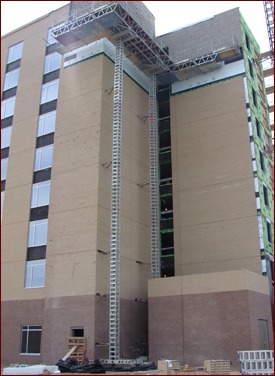 |
|
| Shown is Winco Masonry’s jobsite at Hyatt Place in Houston. |
The last couple of years have been difficult in our industry. With tighter budgets and more people bidding for projects, I feel like I have to show why mast climbers still are the best choice for masonry projects. Mast climbers are, in my opinion, the most efficient, most economical and safest way to scaffold any job in the commercial masonry industry. For these reasons, mast climbers dominated the industry during the last 10 years. With things looking up in the future, I feel they will again.
The case for mast climbers
The main reasons for choosing mast climbers over traditional scaffolding are versatility, speed, lifting capacities and increased production. I mentioned earlier that using mast climbers will increase production by 20 percent or more. Here’s how: A typical mast climber has fewer pieces and parts than traditional scaffolding, making setup and installation easier and less time consuming.
Mast climbers use bridges that connect to the main climbing units, which gives you the ability to fit a mast climber into an area as small as five feet or as wide as 144 feet. Mast climbers also give you the flexibility of working around different types of facades using longer outriggers or forward-extension bridging. With speeds ranging from three feet to 39 feet per minute, and lifting capacities up to 20,000 pounds, mast climbers allow versatility that traditional scaffolding cannot. The working platforms vary in size from 42 inches to seven feet wide, allowing laborers to have more room to stock material and assist the masons. Mast climbers also are designed to keep masons laying material at waist level all day long. This will reduce back injury and fatigue, while increasing performance and production.
Mast climbers become an economical option, when you compare the labor savings and increased production versus other scaffolding options.??Whether you rent or purchase, you will be increasing your bottom line.
Safety
A major factor when considering using mast climbers is safety. Guardrails have a top rail, mid rail and a toe board built into them. One of the No. 1 OSHA violations for masons in the past has involved planking. When you own or rent mast climbers, you??reduce the amount of planks on a job by more than two-thirds, since you only need planking for the outriggers.??Mast climbers will reduce the number of accidents caused by planking issues, and will help eliminate OSHA violations.
At Premier Scaffold Solutions, safety is our top priority, and with our extensive training program and continuing education, we ensure masons have peace of mind when using our equipment. We have three levels of training: one for operators, one for installers and one for train to trainer. We can do training for operators and installers on the jobsite, and we offer a trainer program at our facility in Apopka, Fla. After completing our training classes, end-users will have the knowledge and capability to set up, install and operate the ProSeries without any hesitation.
Renting versus buying
With more projects looking to start in 2011, the time has come to look at the purchasing versus renting of mast climbers for your masonry projects. When looking at your options to rent or purchase, here are a few things to keep in mind.
The first thing to think about is how long your project is going to last. A short-term project, anything under three or four months, might make renting more attractive. However, if you have a couple of short-term projects lined up afterward, or your project will run into six months or longer, then purchasing may be a viable option.
You also might consider the rental-purchase option. Rental-purchase options are growing in popularity, due to financing struggles. A final thought: Before you decide to rent or purchase, think about the storage and maintenance of your equipment. If you don’t have the room or personnel to take care of mast climbers, then stick with renting and leave those headaches up to the rental companies.
Homegrown
As I traveled around the country last year setting up new customers, I found them to be extremely excited to have a mast climber option that’s manufactured in the United States. The next thing customers loved about the ProSeries is the galvanization. Customers are concerned about outdated or damaged equipment showing signs of rust and holes and deeming it unsafe. The ProSeries Mast climber makes it easier to replace these aging mast climbers, since its modular bridging is compatible with other mast climbers on the market. When mast climber owners need to upgrade their power units, the ProSeries will be their best option, based on quality, price, longevity and durability of a galvanized product.
